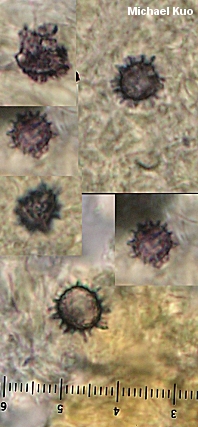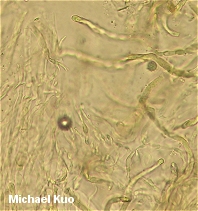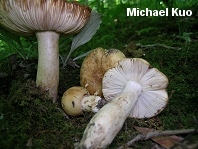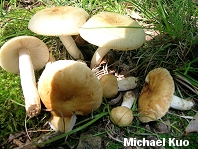Russula laurocerasi (MushroomExpert.Com) (original) (raw)
Russula laurocerasi
[ Basidiomycetes > Russulales > Russulaceae > Russula . . . ]
by Michael Kuo
Russula laurocerasi, like the similar Russula fragrantissima, is a dull yellow member of the foetid russula group. Its fragrant odor is reminiscent of almonds or maraschino cherries (though not quite as pleasant), and once you have smelled it you are not likely to forget it.
While Russula laurocerasi is fairly easily separated from most other foetid russulas (see the key for details), it can only be separated from Russula fragrantissima with difficulty. In theory, the odor of Russula fragrantissima is more foul smelling by maturity; Russula fragrantissima tends to be a bit larger and stockier; and the ornamentation on the spores of Russula laurocerasi is much more striking, with spines and ridges protruding up to 2.5 µ or more (characterized by one author as "wings").
However, R. L. Shaffer concedes in his monograph of subsection Foetentinae (1972) that "[i]ntermediates between these species exist," and my own collecting experience confirms this idea. Perhaps there is only one species involved, variable in its morphology--or perhaps there are several species, not easily separated with traditional morphological characters.
Description:
Ecology: Mycorrhizal with hardwoods; growing alone, scattered, or gregariously; summer and fall; apparently distributed east of the Great Plains.
Cap: 3.5-13 cm; convex or cushion-shaped when young, becoming broadly convex to flat, with or without a shallow depression; slimy when wet and fresh; dull yellow to yellowish or brownish yellow; the margin lined at maturity; the skin peeling away easily at the margin, sometimes beyond halfway to the center.
Gills: Attached to the stem; close or nearly distant; sometimes forked near the stem; whitish to creamy or orangish; often discoloring yellowish brown to brownish, but not bruising.
Stem: 2.5-11 cm long; 1-3 cm thick; white, discoloring brownish to yellowish or reddish near the base; dry; often becoming cavernous; more or less smooth.
Flesh: White; unchanging when sliced.
Odor and Taste: Odor fragrant, reminiscent of maraschino cherries, almonds, or benzaldehyde; taste acrid.
Spore Print: Creamy.
Chemical Reactions: KOH on cap surface pinkish to orangish. Iron salts on stem surface negative to pinkish or orangish.
Microscopic Features: Spores 7.5-11 x 7.5-9 µ; broadly elliptical or nearly round; with warts and ridges from 1-2.5 µ high; with connecting lines that may form a partial or nearly complete reticulum. Pleurocystidia positive in sulphovanillin. Pileipellis a cutis embedded in a gelatinous matrix; pileocystidia clavate to fusiform or subcapitate, ochraceous-refractive in KOH and positive in sulphovanillin.
REFERENCES: Melzer, 1920. (Shaffer, 1972; Smith, Smith & Weber, 1979; Kibby & Fatto, 1990; Phillips, 1991/2005; Lincoff, 1992; Barron, 1999; Roody, 2003; McNeil, 2006; Miller & Miller, 2006; Binion et al., 2008.) Herb. Kuo 06230402, 07180704.
This site contains no information about the edibility or toxicity of mushrooms.
<
<
© MushroomExpert.Com

